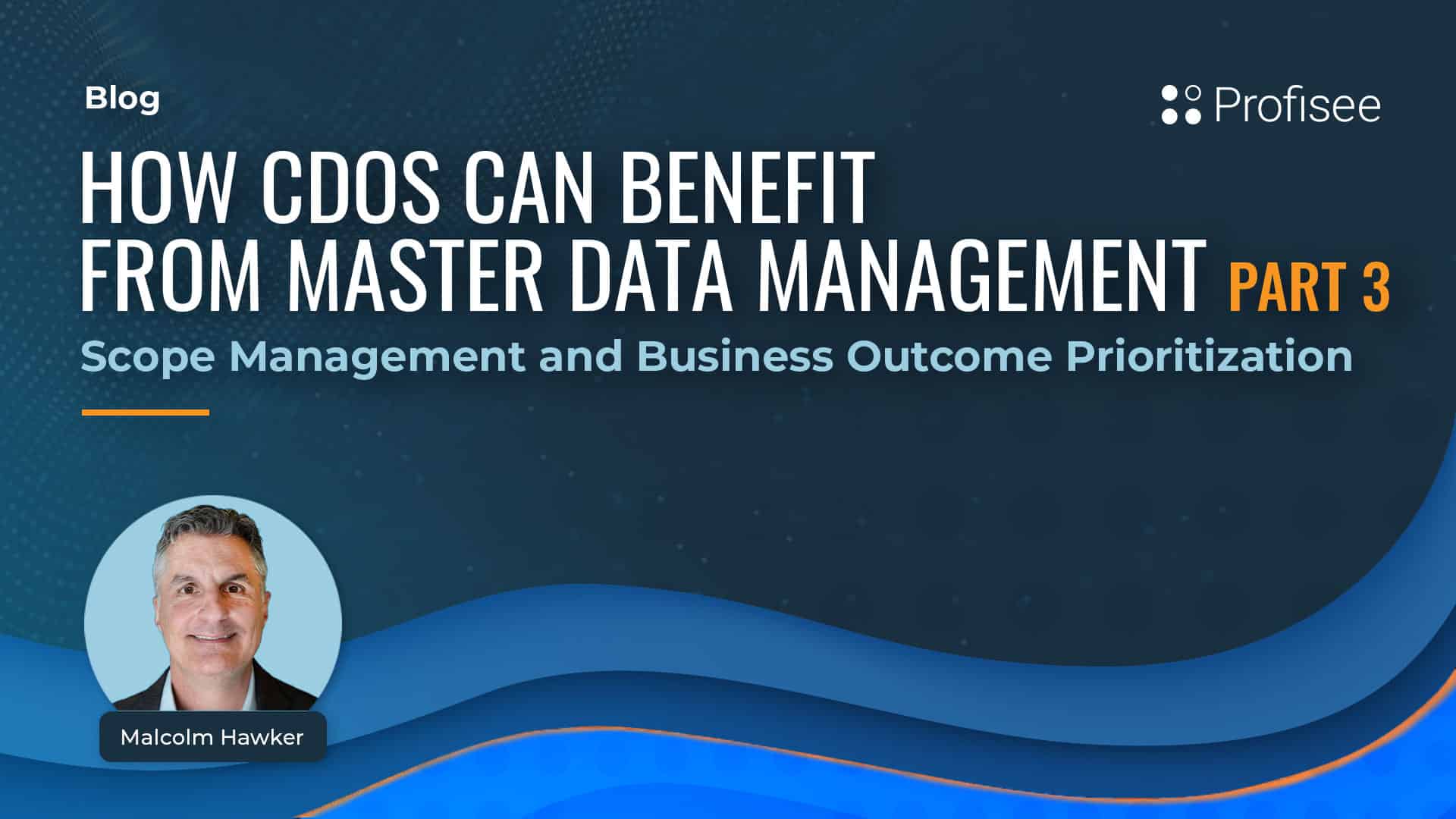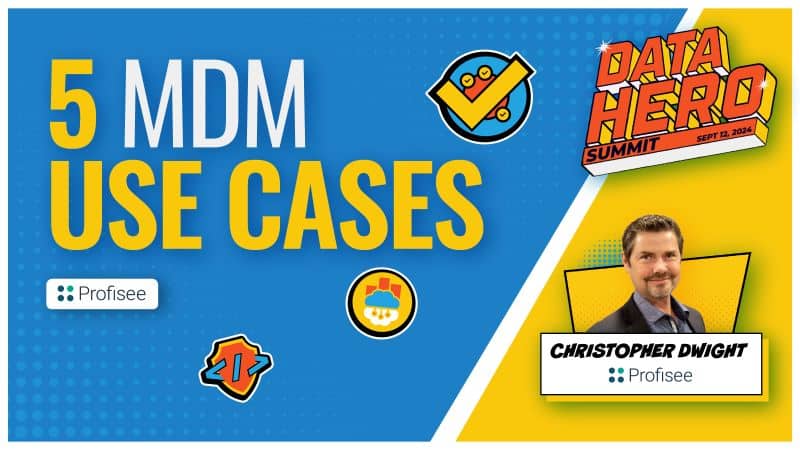As you read in part two of our series, master data management (MDM) has several features and functionalities that allow your enterprise data to drive business outcomes. When launching an MDM initiative, it is crucial to have an endgame in mind for your business. You cannot reap the benefits of business growth and value without understanding the “how” of MDM and what it provides.
With that in mind, only having a vague or unfocused idea of what you are hoping to accomplish for your organization will ultimately hurt your implementation. You need to have specific outcomes and goals in place so that you won’t try and do too much all at once. When it comes to leaving a big MDM impact, less is more.
This requires you to take a step back and evaluate the exact functionalities needed to resolve a particular use case and achieve a certain business goal. In other words, keep your scope in check. When it comes to resolving individual problems or focusing on a priority, it is important to take things one step at a time.
Here are some important things to remember when managing your MDM scope and pinpointing the desired outcomes:
Prioritizing Business Value Over Data Quality
CDOs and data analysts are interested in implementing MDM for varied reasons. While these distinct reasons are both parts of the overall MDM project scope, their interests lie in different steps of the process.
For the lack of a better metaphor, analysts are interested in the quality of the soil while CDOs are interested in the resulting harvest after the seeds are planted. While the foundational quality of your critical data is important, it must bring significant business value for CDOs to remain invested — both literally and figuratively.
It all comes down to the “what’s in it for me” mindset. The bottom line is that CDOs do not care about poor data quality. They prioritize business outcomes and value over anything else.
While MDM catalyzes both things, there must be a focus on what MDM can bring over what it does. This requires taking the word “data” out of master data management. As much as data is a part of the initiative, that is not how CDOs evaluate MDM success.
Once you start viewing your MDM initiative from a value-based perspective, you can prioritize what specifically needs to be done with MDM and manage your scope accordingly.
Optimizing Business Outcome with Master Data Management
First, focus on your desired business outcome and work backward from that. In the context of your MDM implementation, what will lead you to that desired point? To optimize valuable business outcomes, you must scale your MDM integration to fit your company’s needs.
Scaling your deployment is what allows you to control what you use MDM for within your organization. It can determine anything from the functionalities you use — address verification, name recognition, etc. — to the type of data you choose to prioritize — for example, customer or geographical data. By catering your MDM implementation to work for your enterprise’s specific needs, you can then reap the most value for what you are aiming to accomplish internally.
It may seem tempting to manage all your data at once, but sometimes you need to stop, step back and evaluate what will deliver the most long-term value for growing your business.
Managing Scope for a Specific Master Data Management Strategy
When it comes to kicking off an MDM strategy, it is not a “one-size-fits-all” deployment. Because every company has different goals and priorities, no singular MDM project should completely match that of another enterprise.
Before deployment, you need to bootstrap your strategy and remain razor-focused on your desired outcomes and goals for growing your business. This is what is known as scope management.
Ask yourself what you ultimately hope to achieve. Once you have evaluated the outcomes, value and growth, scale your MDM standards and structure to reflect that. From there, you can manage and maintain those established values — your scope. Keep your eye on the prize and avoid hasty decisions. When starting, you want to minimize your scope and start smaller.
The bottom line is that you never want to develop a scope that you know you cannot deliver. This upsets CDOs and jeopardizes your chances for future MDM endeavors because they did not receive what was initially promised. It can be tempting to go big and master everything after the success with your first use case but resist that impulse and remain focused.
Always keep your scope in check if you want to deliver another use case in the following months. MDM success stories take time!
Be Pragmatic in Your Approach
With prioritization and scope management working hand in hand, you also want to be pragmatic in your approach throughout the digital transformation process. Go where MDM is wanted within your organization and locate a solid stakeholder with legitimate needs. You are only wasting time if you shift your MDM focus to the wrong parties.
There are times when certain leaders simply do not have MDM-related business priorities. Forcing MDM where it isn’t needed is like jamming a square peg into a round hole. Find where you are wanted and devote your time to interested stakeholders expressing a desire to implement MDM as a legitimate solution.
How Profisee Can Help
Because managing your scope and focusing on specific business outcomes are such crucial components for MDM success, you need to select a vendor that shares those same values. Before trusting an MDM vendor that tries to do too much too fast, confirm that the deployment promised aligns with your own enterprise needs and provides you with exactly what is necessary to deliver on established use cases. Throwing noodles at the wall and seeing what sticks is not a suitable MDM approach. Business value is driven by purpose.
At Profisee, we understand that every business is different. That is why our “make it scale” approach to MDM provides you with a data management platform that grows with you. Our scalable, multi-domain solution provides you with comprehensive coverage of all data types allowing for a complete, 360-degree view of your business. By establishing your own MDM and data governance standards, you can leverage your data your way.
Now you can make your strategic initiatives happen with an MDM approach scaled to fit your organization!
As the final decision-maker for the project, CDOs evaluate MDM success with measurable value. To deliver significant value, you need to manage your scope with a scaled approach to data management. From there, your CDO and your data quality will benefit from your implementation ensuring both financial and operational support for future MDM projects to come.
Malcolm Hawker
Head of Data Strategy @ Profisee

Malcolm Hawker
Malcolm Hawker is a former Gartner analyst and the Chief Data Officer at Profisee. Follow him on LinkedIn.












